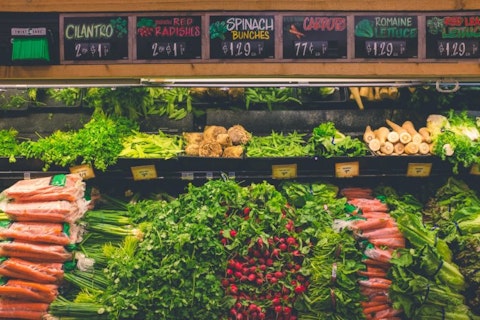In this article, we will be covering the top 20 countries with the highest vegetable consumption per capita. If you want to skip our detailed analysis of the vegetable industry and consumption trends, go directly to the Vegetable Consumption per Capita by Country: Top 5.
According to the latest data compiled by the Food and Agriculture Office (FAO) of the United Nations, the total annual consumption of vegetables stands at 965.11 million tons as of 2020. Among all the leading nations, Croatia is the country that eats the most vegetables per person. On the other hand, on a per capita basis, Chad eats the least vegetables in the world. The annual per capita vegetable consumption in Chad stood at a mere 4.94 kg in 2020. According to Zion Market Research, the vegetable seeds market was valued at $8.6 billion in 2021. The market is predicted to expand at a compound annual growth rate (CAGR) of 10.35% in the next five years to reach a size of $14.5 billion by 2028. Overall, China consumes the most vegetables in the world, as it was responsible for consuming 555.42 million tons or 57.6% of the total worldwide vegetable consumption in 2020. On the other hand, Dominican Republic ranks first place in fruit consumption per capita by country rankings.
The vegetable industry, along with the fruit industry, is highly globalized, with significant trade occurring between countries. This trade allows for a wider variety of vegetables and fruits to be available year-round in different regions. Countries with favourable climates and efficient supply chains have a competitive advantage in vegetable exports, while importers benefit from accessing produce during off-seasons. Comprehensive fruit and vegetable consumption statistics revealed that vegetables were the 11th most traded product in the world, as the commodity’s global trade was valued at $638 billion in 2021. In terms of vegetable consumption per capita by country, Tomato is the most consumed vegetable in the world.
There are a number of prominent companies operating in the vegetable industry. For instance, Dole plc (NYSE:DOLE) is a leading name in the vegetable industry as the Dublin, Ireland-based company has the distinction of being the biggest producer of fruits and vegetables globally. Dole has been a prominent player in the produce industry for many years, offering a variety of high-quality vegetables to consumers worldwide. Another prominent public company in the vegetable industry is Santa Paula, California-based Calavo Growers, Inc. (NASDAQ:CVGW). The company is known for its expertise in the avocado industry, but it also offers a range of other fresh produce, including vegetables. Some of the other leading agriculture stocks include Archer-Daniels-Midland Company (NYSE:ADM), Bunge Limited (NYSE:BG), and Corteva, Inc. (NYSE:CTVA). If you want to read about more stocks, head over to Agriculture Stocks List: 25 Biggest Agriculture Stocks.
Our Methodology
We obtained the annual vegetable consumption data for all the countries from the Food and Agriculture Office (FAO) of the United Nations. To calculate the vegetable consumption per capita for each country, we divided the annual consumption by the total population figures sourced from the World Bank. The countries have been ranked in ascending order of their vegetable consumption per capita as of 2020.
Vegetable Consumption per Capita by Country: Top 20
20. Türkiye
Vegetable Consumption Per Capita: 118.45 kg
Population: 84,339,070
Total Annual Vegetable Consumption: 14.79 million tons
Türkiye has a diverse street food culture, and vegetables are often featured in popular street food items. For example, roasted corn (mısır), stuffed baked potatoes (kumpir), and vegetable-filled flatbreads like gözleme are widely enjoyed by locals and tourists alike. In the Black Sea region, leafy greens like kale (kara lahana) and Swiss chard (pazı) are popular, while eggplant-based dishes are common in southeastern Anatolia.
19. Hong Kong
Vegetable Consumption Per Capita: 125.53 kg
Population: 7,496,980
Total Annual Vegetable Consumption: 1.06 million tons
Hong Kong is a Special Administrative Region (SAR) of China and a major global financial hub located on the southeastern coast of China. Dim sum, a style of Cantonese cuisine, is a popular culinary tradition in Hong Kong. Dim sum meals typically include a variety of small dishes, many of which feature vegetable-based fillings, such as steamed vegetable dumplings, stuffed peppers, and vegetable spring rolls.
18. Mali
Vegetable Consumption Per Capita: 126.11 kg
Population: 20,250,830
Total Annual Vegetable Consumption: 2.89 million tons
Mali is a landlocked country situated in West Africa. The Malian diet primarily consists of staple foods such as millet, sorghum, and rice, which are often complemented with vegetables. Vegetables are an important component of traditional Malian dishes, providing essential nutrients and flavours. Mali has a rich agricultural heritage, and a variety of vegetables are grown locally, which results in a high per capita consumption as well.
17. Macao
Vegetable Consumption Per Capita: 126.78 kg
Population: 649,340
Total Annual Vegetable Consumption: 84,000 tons
Macao was a former Portuguese colony that became a SAR of China in 1999. Macao’s culinary scene is influenced by both Cantonese and Portuguese cuisines. Vegetables are widely incorporated into various dishes, blending both Chinese and European cooking styles. Popular dishes comprise stir-fried vegetables, vegetable-filled dumplings, Portuguese-style vegetable stews, and vegetable sides served alongside meat or seafood dishes.
16. Nepal
Vegetable Consumption Per Capita: 133.07 kg
Population: 29,136,810
Total Annual Vegetable Consumption: 4.23 million tons
Nepal, located in South Asia, is known for its rich traditions and unique cuisine. Nepali cuisine revolves around staple foods like rice, wheat, maize, and lentils. Dal Bhat, a traditional meal consisting of lentil soup, rice, and vegetable curries (Tarkari), is a staple in the Nepali diet.
15. Algeria
Vegetable Consumption Per Capita: 144.54 kg
Population: 43,851,040
Total Annual Vegetable Consumption: 6.92 million tons
Algeria’s fertile land and diverse climate allow for the cultivation of a wide range of vegetables. Commonly consumed vegetables in the country are tomatoes, onions, carrots, bell peppers, eggplant, zucchini, potatoes, and various leafy greens such as lettuce and spinach.
14. Tunisia
Vegetable Consumption Per Capita: 150.78 kg
Population: 11,818,620
Total Annual Vegetable Consumption: 2.04 million tons
Tunisia has a strong street food culture with a wide variety of vegetable-based snacks and dishes. Popular street foods include brik (a deep-fried pastry filled with various ingredients, including vegetables), falafel (fried chickpea balls served with vegetables and sauces), and fricassé (a sandwich filled with vegetables, tuna, and harissa sauce).
13. Tajikistan
Vegetable Consumption Per Capita: 160.38 kg
Population: 9,537,650
Total Annual Vegetable Consumption: 1.92 million tons
Tajikistan is a Central Asian country that has fertile valleys and a favourable climate that allows the cultivation of vegetables. Plov, a traditional rice dish cooked with meat and vegetables, is one of the most popular and iconic dishes in Tajik cuisine. Vegetables like carrots and onions are often featured prominently in this dish, providing flavour and texture.
12. South Korea
Vegetable Consumption Per Capita: 164.23 kg
Population: 51,269,180
Total Annual Vegetable Consumption: 9.68 million tons
South Korea has a diverse range of locally grown vegetables due to its mild climate and fertile land. Kimchi, a fermented vegetable dish, holds a significant place in Korean cuisine and is considered a national staple. Cabbage kimchi, made with fermented napa cabbage, is the most popular variety in the country.
11. Vietnam
Vegetable Consumption Per Capita: 169.34 kg
Population: 97,338,580
Total Annual Vegetable Consumption: 17.94 million tons
Vietnam has an abundance of vegetables due to productive land and a favourable climate. Vietnamese cuisine emphasizes the importance of balance in flavours and textures. Vegetables play a crucial role in achieving this balance by adding freshness, crunch, and vibrant colours to meals. Vegetables are commonly used in stir-fries, salads, spring rolls, and soups.
10. Armenia
Vegetable Consumption Per Capita: 170.44 kg
Population: 2,963,240
Total Annual Vegetable Consumption: 542,000 tons
Armenia is a landlocked country in the South Caucasus region. Armenian cuisine features several traditional dishes where vegetables play a prominent role. Yershig, a vegetable stew made with eggplants, tomatoes, and peppers, is a traditional Armenian dish.
9. Uzbekistan
Vegetable Consumption Per Capita: 173.79 kg
Population: 33,469,200
Total Annual Vegetable Consumption: 7.51 million tons
Uzbekistan is a Central Asian country that grills vegetables alongside meat-based dishes like shashlik (skewered meat), which is a renowned dish in the country. Vegetables like tomatoes, onions, and bell peppers are commonly grilled alongside the meat, adding a smoky and flavorful element to the dish. Uzbek cuisine contains a variety of vegetable-based salads and side dishes as well.
8. North Macedonia
Vegetable Consumption Per Capita: 180.67 kg
Population: 2,083,370
Total Annual Vegetable Consumption: 487,000 tons
North Macedonia is a country located in the Balkan Peninsula in Southeast Europe. North Macedonian cuisine features a variety of vegetable-based traditional dishes. For example, “tarator” is a cold soup made with cucumbers, yoghurt, garlic, and herbs.
7. Kazakhstan
Vegetable Consumption Per Capita: 190.26 kg
Population: 18,776,710
Total Annual Vegetable Consumption: 5.44 million tons
Kazakhstan is another country on the list that belongs to the Central Asian region. Traditional Kazakh cuisine is heavily impacted by its nomadic history and the cultures of its various ethnic groups. Salads and vegetable-based appetizers are commonly enjoyed in Kazakhstan. “Shalgam” is a traditional Kazakh salad made with tomatoes, cucumbers, onions, and herbs.
6. Laos
Vegetable Consumption Per Capita: 212.98 kg
Population: 7,275,560
Total Annual Vegetable Consumption: 1.68 million tons
Laos is another landlocked country on the list that is located in Southeast Asia. Lao cuisine features an array of soups and salads that include vegetables. “Tom Jeud” is a popular clear soup in the country made with vegetables and herbs, while “larb” is also a minced meat salad with a generous amount of vegetables. Salads like “tam mak hoong” (papaya salad) and “yam” (spicy salad) also contain vegetables as key ingredients.
Some of the leading companies benefitting from high global vegetable consumption include Archer-Daniels-Midland Company (NYSE:ADM), Bunge Limited (NYSE:BG), Calavo Growers, Inc. (NASDAQ:CVGW), and Corteva, Inc. (NYSE:CTVA).
Click to continue reading and see the Vegetable Consumption per Capita by Country: Top 5.
Suggested Articles:
- 15 Most Valuable Mining Companies in the World
- Top 25 Most Educated Countries in the World
- 10 Most Valuable EdTech Companies in the World
Disclosure. None: Vegetable Consumption per Capita by Country: Top 20 is originally published on Insider Monkey.






